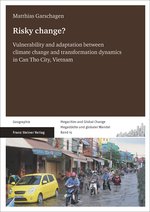Risky Change? Vulnerability and adaptation between climate change and transformation dynamics in Can Tho City, Vietnam

With empirical analysis of Can Tho City, Vietnam, this book attends to the critical question of how socioeconomic transformation processes affect vulnerability related to natural hazards. By focusing on a medium-sized city in an emerging economy, Matthias Garschagen studies the causal links among vulnerability, economic development and human development change. This book provides an excellent and in-depth study of the literature and existing frameworks for interpreting vulnerability and adaptation to natural hazards. It also explore influences from both state and non-state actors. Thus Garschagen creates a book that not only fills a gap in the literature, but offers foundational knowledge for anyone studying, working or interested in the field of climate change and responses to natural hazards. Furthermore, its mixed-methods approach offers considerable inspiration for those planning or conducting empirical research.
Risky Change? in essence lays out Garschagen’s own research thesis. It comprises eight chapters, which lead you through his research process. Chapter 1 introduces Garschagen’s study and outlines the study’s rationale. It also identifies three key gaps in risk research pertaining to vulnerability and adaptation, and in response presents two main questions and a number of theoretical, empirical and methodological sub-questions that guide the research.
Attending to the theoretical background, Chapter 2 is a particularly meaty chapter and purposefully discusses umbrella concepts of risk, vulnerability, adaptation and resilience in an integrated manner (page 30). Here sections include: relevant discourses on risk in human–environment interactions; links among concepts of vulnerability, adaptation and resilience; theoretical underpinnings of action related to vulnerability and adaptation; vulnerability, adaptation and resilience in cities; and governance and management of urban risk and adaptation.
Springing from the literature review in Chapter 2, Chapter 3 presents an advanced integrated conceptual framework, which seeks to overcome current deficits in approaches to vulnerability and adaptation. Merely seven pages long, this chapter nevertheless is a critical juncture for the book. Indeed it highlights one of Garschagen’s key conceptual contributions to literature and also helps to guide the empirical analysis and interpretation of Garschagen’s study of Can Tho.
Chapter 4 details the risk landscape of Vietnam by describing its natural hazards and projected climate change impacts, alongside its high levels of vulnerability and deficits in adaptation and disaster risk reduction (page 116). Furthermore, this chapter examines the ongoing socioeconomic and political transformations in Vietnam.
In Chapter 5 Garschagen sets forth his methodology for studying Can Tho. Following an outline of the research design, this chapter outlines the mixed-methods approach for data collection and analysis, the selection of case study areas, and the limits and obstacles of the data collection.
Chapter 6 thus presents the empirical findings stemming from the data collection outlined in the previous chapter. These are set out within two broad sections: first, the achievements and deficits of governmental risk management in Can Tho City; and second, vulnerability and adaptation at the household level.
Following on to discuss these empirical findings, Chapter 7 has four parts. The first part uses a contextual lens to view the empirical results and to offer increased understanding of vulnerability and adaptation dynamics in Vietnam and particularly Can Tho City. The second part assesses the epistemological and methodological elements of the study. In part three, the study’s achievements to further theoretical discourse, especially in light of Garschagen’s advanced conceptual framework, are discussed. Finally part four makes recommendations to practitioners and policymakers.
To conclude, Chapter 8 reflects upon the motivations of this empirical study, especially its contributions to understanding the dynamics of vulnerability and adaptation alongside socioeconomic and political transformations of countries.
Book note prepared by Hannah Keren Lee
Search the Book notes database
Our Book notes database contains details and summaries of all the publications included in Book notes since 1993 - with details on how to obtain/download.
Use the search form above, or visit the Book notes landing page for more options and latest content.
For a searchable database for papers in Environment and Urbanization, go to http://eau.sagepub.com/

